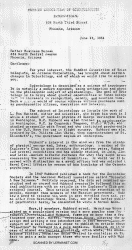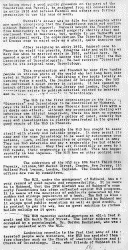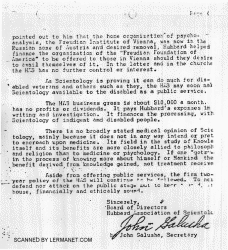by John Galusha
SCIENTOLOGY -- L. RON HUBBARD'S
INCORRIGIBLE BRAINCHILD




HUBBARD ASSOCIATION OF
SCIENTOLOGISTS INTERNATIONAL
806 North Third Street
Phoenix, Arizona
June 12, 1954
Better Business Bureau
834 North Central Avenue
Phoenix, Arizona
Gentlemen:
For your interest, the Hubbard
Association of Scientologists, an Arizona Corporation, has brought about
certain changes in Scientology, and of which we would like to acquaint
you.
Scientology is described as a
science of knowingness. It is actually a modern approach, using
mathematics and physics to the philosophic subject of epistemology.
The goal of Scientology is to bring about greater capabilities in human
beings such as increases in recognition, memory, and reaction time.
Such a science would of course address various phenomena such as
psychosomatic illness, aberration and behavior.
The subject of Scientology
is largely the work of L. Ron Hubbard, author and scientist, who began
his work in __ while a student of
nuclear physics at George Washington University in Washington, D.C.
Hubbard was also trained in
psycho-analysis, studied personally with Freud and who instituted
psycho-analyses in the U.S. Navy for use in flight surgery.
Hubbard was also trained by Dr. William Alan White, then superintendent
of St. Elizabeth's, the government asylum at Washington.
Hubbard's interest in the
mind was from the standpoint of physical energy and, later,
anthropology. A member of the Explorer's Club in good standing for
eighteen years, Hubbard has led several expeditions and has widely
studied, in Asia, Alaska, and Latin America barbaric cultures for what
they might reveal concerning the motivations of humanities. In
World War II he served with distinction as a naval officer and was
selected as Naval Civil Affairs by reason of his knowledge of the
Oriental psychology.
In 1947 Hubbard published a
book for the Gerontology Society and the American Medical Association
called "Scientology & New Science." Politely received, the data
yet remained unstudied and so unused and Hubbard eventually followed
this original publications with an article in the Explorer's Club
professional journal. This article attracted the attention of some
people, amongst them members of the Russian government. Hubbard
saw a need to release his work in more detailed form, and received an
offer from Hermitage House, Inc., one of the better publishers of
psychiatric texts, he consented to write a formal book.
Here, if anywhere, Hubbard
erred. Hermitage House insisted on a popularized version and a
more popular name for the subject (Dianetics) and Hubbard, foreseeing no
more than a few thousand copy sale, agreed. Hermitage House,
altering the manuscript and writing a new introduction (a fact which
became the subject of a suit) unwisely chose to publish an article about
"Dianetics" by Hubbard in a pulp magazine. Hubbard, as in the case
of almost any nuclear physicist, often wrote for amusement, science
fiction. Hermitage House desired to capitalize on this fact to
gain a sale amongst those who were familiar with Hubbard's name.
The book, called "Dianetics:
Modern Science of Mental Health" startled the publishing world, and
Hubbard, by climbing high into the best-seller listing of the New York
Times and staying there for months. Such instant popularity found
Hubbard prepared for the floods of mail and pleas for help.
Hubbard, interested only in
research, financially independent, without such royalties, was glad to
listen to a proposal from one C. Parker Morgan and his publisher to let
them form a Foundation to service this demand. Seven trustees, of
which Hubbard was only one, formed on June 1, 1950 the Hubbard Dianetic
Research Foundation of Elizabeth, New Jersey. Hubbard gave them
the book and its royalties and returned to his own pursuits.
This organization, however,
pressed heavily upon him for lectures and disturbed his own routine.
Yet this corporation insisted on growing, forming other corporations in
Illinois, California and Hawaii, each with a duplicate directorate.
In November, 1950 Hubbard
became convinced that the corporation was not sound and that it would
not attain to its professed goal of helping people. He attempted
to withdraw his name from it and was variously inveighed against.
He had only one vote in seven. Forced to leave it in possession
and continued use of his name, he retired in December to Palm Springs,
California where he set up a modest research laboratory. Although
he did not seek them, many people began to come to him in Palm Springs.
This seriously impaired the business of the Foundation such ___ in Los
Angeles for Hubbard charged nothing.
A.E. van Vogt, the principal
mover in the Los Angeles Foundation and others were intensely provoked
at Hubbard's withdrawal. Hubbard's wife, from whom he had been
separated, also became incensed at him. For public appearance she
had been a Foundation director. With the obvious coming failure of
the Foundations and with it a failure of the income she drew from she
threatened Hubbard with a public scandal if he did not support the
Foundations.
Hubbard, busy writing a new
book, refused to lend any credence to these threats or those of the
Elizabeth board and went to Cuba where he completed a 125,000 word book
in the next many weeks. As their young child had always been under
his, not her mother's care, the child accompanied him.
True to her threats and those
of the Foundation trustees a great deal of scandal was stirred up.
A receivership was __ in Los Angeles by this woman and the trustees to
seize control the Foundations and many statements were made to the
press.
Hubbard made no statements of
any kind during all this period and when he became aware that they had
been made, ordered his separated wife to him, had her sign a confession
to perjury (copy enclosed) and applied for and received a divorce from
her without alimony to her.
Meanwhile the Elizabeth
Foundation over which Hubbard had never had power beyond his
personality, sold itself to one Don G. Purcell, an oilman in Kansas.
Purcell moved the Foundation to
Wichita, Kansas and Hubbard, having completed his book, went to Kansas
to settle various affairs.
Considering that Purcell wished
only to make money from Dianetics, Hubbard sought to reform the attitude
of the Foundation. To accomplish this he supported himself in
Kansas by writing and lecturing and finally, after a few months, unable
to bring about a good public presence on the part of the Foundation and
Purcell, he resigned from all connections in early 1952 and refused
Purcell and others any further permission to use his name or work.
Purcell's answer was to file
for bankruptcy within one month conceiving that the Foundations could
not continue without Hubbard's support. Purcell bought the
Foundations from bankruptcy as his personal property shortly after and
continued them in business, but, unable to use Hubbard's name or
additional work, the organization The Dianetic Foundation of Kansas came
to exist only as a shell, quite inactive today.
After resigning in early 1952,
Hubbard came to Phoenix to visit his parents, liked the city and with
his wife Mary Sue whom he married early in 1952, settled here. He
opened a quiet office which became that fall (1952) the Hubbard
Association of Scientologists. He had reverted "Dianetics" back to
its original name, Scientology.
This organization was founded
by some five hundred people in varoius parts of the world who had long
been interested in Hubbard's work. Publishing a few books locally
and issuing twice a month, the Journal of Scientology, the HAS has
continued a quiet carrer [sic] in Arizona. It has opened up branch
offices in Camden, New Jersey and London, England. ___iation
exists to publish material related to behavior and to _______________ in
Scientology.
The HAS is the first
organization in the field of "Dianetics" and Scientology to be
controlled by Hubbard. It pays its bills promptly as any Phoenix
business firm with which it deals can attest. Although any
organization dealing with behaviour can attract hangers-on, there has
been no consequences of this in the HAS. Hubbard's policy of
quiet, orderly business and investigation is clearly manifested in the
general good repute of the HAS in Phoenix.
In so far as possible the HAS
has sought to associate itself with steady and reliable people. It
does permit its name and the name Scientology to be used by autonomous
organizations. Such, called associates or groups, exist in many
__. They use HAS materials and pay a membership fee but otherwise
have no connection. When they err financially or seem to __ HAS
repute, their membership is cancelled. This has happened recently
in Los Angeles. The HAS has no other control over such persons.
The addresses of the HAS are
806 North Third Street, Phoenix, Arizona, 507 Market Street, Camden, New
Jersey, 15__ Holland Park Avenue, London, England. The Camden and
London offices are run by committees.
The HAS, under the management
of Hubbard, has a __ year record of good repute and responsibility.
It is aware, as is Hubbard, that the 1950 blatant use of Hubbard's name
in early Foundations has often reflected against HAS progress. It
is aware of the mountains of publicity generated by the sudden and
strange popularity of a book. The HAS is also aware that it is the
first organization controlled by Hubbard and it enjoys good public
reputation as well as good credit. It is content to pay its way,
has no great ambition to riches and builds solidly as it goes.
The HAS recently rented
quarters at 401-A East Roosevelt and 616 North Third Street. The
latter address was also occupied by a psychologist, Dr. Gordon Beckstead,
who was in no way connected with the HAS.
Awakening recently to the fact
that many of its interested people were ministers, the HAS has assisted
them to form churches such as the Church of American Science and the
Church of Scientology. Also, when friends of Hubbard in __ pointed
out to him that the home organization of psycho-analysis, the Freudian
Institute of Vienna, was now in the Russian zone of Austria and desired
removal, Hubbard helped finance the organization of the "Freudian
Foundation of America" to be offered to those in Vienna should they
desire to avail themselves to it. In the latter an din the
churches the HAS has no further control or interest.
As Scientology is proving it
can do much for disabled veterans and others such as they, the HAS may
soon make Scientology available to the disabled as a public service.
The HAS business gross is about
$10,000 a month. It has no profits or dividends. It pays
Hubbard's expenses in writing and investigation. It finances the
processing, with Scientology of indigent and disabled people.
There is no broadly stated
medical opinion of Scientology, mainly because it does not in any way
intend or pretend to encroach upon medicine. Its field in the
study of Knowledge itself and its benefits are more closely allied to
philosophy and religion than to medicine or psychology. If one ___
in the process of knowing more about himself or Mankind the benefit
derived from knowledge gained, not treatment received.
Aside from offering public
services, the firm two-year policy of the HAS will continue to be
followed. To neither defend nor attack on the public stage, but to
keep _____________house, financially and ethically sound.
Sincerely,
Board of Directors
Hubbard Association of Scientology
by John Galusha, Secretary